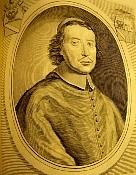Name Giambattista Rubini | ||
 | ||
Giambattista Rubini (1642 – 17 February, 1707) was a Catholic cardinal from 1690 to 1707.
Contents
Early life and career
Giambattista Rubini was born in Venice in 1642, the second son of Donato Rubini and Cristina Medici. His grandmother, Cristina Ottoboni, was the sister of Pope Alexander VIII.
He was educated at the University of Padua, becoming a doctor of both laws.
He became a canon of Padua Cathedral at an early age. After law school, he moved to Rome to become Referendary of the Apostolic Signatura. He later became governor of the cities of Fabriano, Spoleto, Frosinone, Viterbo, and Macerata. He then went on to be governor of the Campagne and Maritime Province, Umbria, and the March of Ancona.
Rubini received the minor orders on September 10, 1683; became a subdeacon on September 12, 1683; and was made a deacon on September 19, 1683. He was ordained to the priesthood on September 21, 1683.
On May 15, 1684, the cathedral chapter of Vicenza Cathedral elected him to be Bishop of Vicenza. He was consecrated as a bishop by Cardinal Alessandro Crescenzi on May 21, 1684.
Cardinalate
Rubini's great-uncle, Pope Alexander VIII, named him Cardinal Secretary of State in October 1689. The pope made him a cardinal priest in the consistory of February 13, 1690. On April 10, 1690, he received the red hat and the titular church of San Lorenzo in Panisperna. He was made papal legate to Urbino on September 27, 1690.
After Alexander VIII's death, Cardinal Rubini participated in the papal conclave of 1691, which elected Pope Innocent XII. The new pope did not name Rubini as his Secretary of State.
He later participated in the papal conclave of 1700, which elected Pope Clement XI. He resigned as Bishop of Vicenza on March 25, 1702. On January 15, 1703, he was named Camerlengo of the Sacred College of Cardinals, and he held that office until January 14, 1704. On March 25, 1706, he opted for the titular church of San Marco.
He died in Rome on February 17, 1707. He was buried in the church of San Marco.
